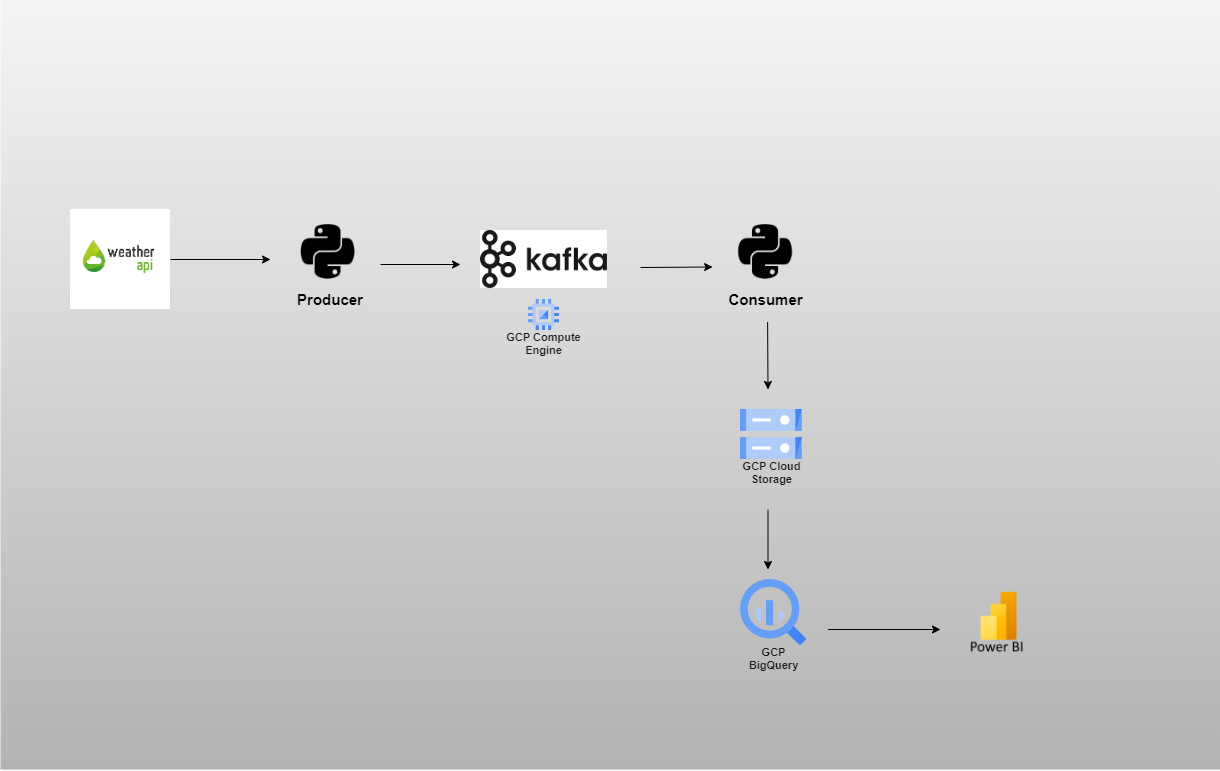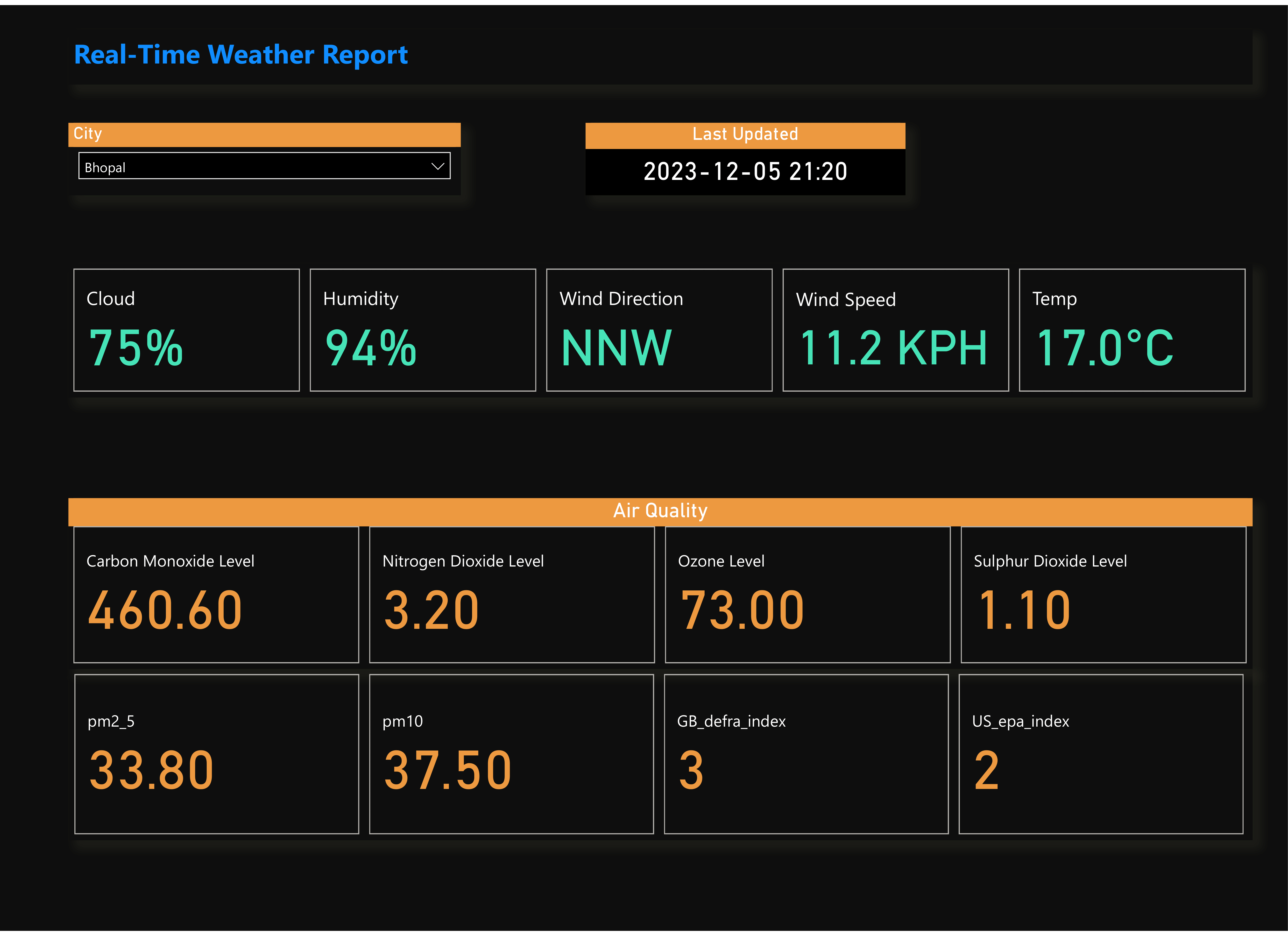Kafka-Weather-Data-Engineering-Project
Real-Time Weather Data Engineering with Kafka
Access my project files here - Kafka-Weather-Data-Engineering-Project
Introduction
This project showcases a real-time streaming pipeline utilizing Kafka to integrate a Weather API for live weather data collection. A producer program efficiently gathers this data and feeds it into a Kafka cluster for seamless ingestion. The consumer program, focusing on simplicity, stores each key-value pair as a JSON file directly into Google Cloud Storage (GCS). Utilizing BigQuery, an external table is established on the GCS bucket, facilitating structured querying and analysis of the stored JSON-formatted data. This repository provides insights and a guide into building an end-to-end real-time data engineering solution for weather data.
Dataset
For this project, I’m utilizing the Weather API to collect real-time data for various cities. You can explore the API and find detailed information at the provided link below:
Architecture

Technology Used
Programming Languages
- Python
Google Cloud Platform
- Google Cloud Storage
- Google Cloud Compute Engine
- Google Cloud BigQuery
- Google Cloud VPC Network
Other Tools
- Apache Kafka
- Data Visualization: Power BI
Project Steps
- Data Collection with Weather API:
- Explored and identified a free Weather API for collecting real-time weather data.
- Created a free account to obtain an access key for data collection.
- Setting Up Kafka Cluster:
- Utilized GCP Compute Engine’s service to provision VM with the “Apache Kafka Server on Ubuntu Server 20.04” image, facilitating a streamlined installation process without the need for a separate Kafka setup.
- Setting Up Firewall Rule:
-
Created an Ingress firewall rule to enable access to the Kafka server from the local machine.
-
-
Changing Kafka “ADVERTISED_LISTENERS” Properties:
- Updated the “ADVERTISED_LISTENERS” properties in the Kafka server configuration (
config/server.properties) to utilize the VM’s public IP address for external connectivity.
- Updated the “ADVERTISED_LISTENERS” properties in the Kafka server configuration (
-
Producer Program Implementation:
- Created a producer program in Python to continuously fetch real-time weather data for specific cities.
- Integrated a time interval (
time.sleep(5)) to facilitate efficient data consumption by Kafka consumers. - Installed the
kafka-pythonpackage to develop the Kafka program using Python.
-
Consumer Program for GCS:
- Developed a consumer program to store key-value pairs directly as individual JSON files into Google Cloud Storage (GCS).
- Generated unique JSON files, each labeled with timestamps and UUIDs for maintaining data uniqueness.
- Created a dedicated Service Account with Google Cloud Storage (GCS) admin access, enabling the consumer program to write data seamlessly to the GCS path.
-
Creating Bucket in GCS for Storage:
- Created a dedicated bucket within Google Cloud Storage (GCS) to store weather data in JSON format.
-
Creating External Table in BigQuery:
- Set up a BigQuery external table connected to the GCS bucket, enabling seamless SQL querying and analytics on the JSON-formatted weather data stored within GCS.
-
Power BI Dashboard Visualization:
- Designed an interactive Power BI dashboard using the external BigQuery table. This dynamic dashboard provides intuitive and interactive visualization of weather data, offering a user-friendly experience for exploring information across various cities.

Conclusion
In conclusion, this project successfully demonstrates the construction of a robust real-time streaming pipeline using Kafka, seamlessly integrating a Weather API for live data collection. The implementation of producer and consumer programs facilitates efficient data ingestion and storage in Google Cloud Storage (GCS), complemented by the utilization of BigQuery for structured querying and analysis. The Power BI dashboard enhances user interaction and visualization of weather data insights. Moving forward, potential enhancements could include scalability improvements and additional analytics for deeper insights into weather patterns.